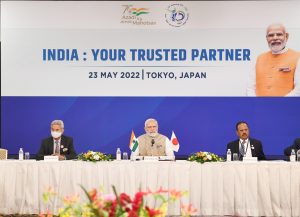India has joined the Indo-Pacific Economic Framework (IPEF) launched by the United States on the side lines of the Quad Summit in Tokyo on May 23-24. This initiative has 13 members: Australia, Brunei, India, Indonesia, Japan, Malaysia, New Zealand, the Philippines, Singapore, South Korea, Thailand, the United States, and Vietnam. IPEF is based on four pillars: supply chain resilience; clean energy, decarbonization, and infrastructure; taxation and anti-corruption; and fair and resilient trade.
This grouping is intended to counter China’s economic dominance in the Indo-Pacific region. A White House briefing mentions IPEF as not being a traditional free trade agreement. Indian Prime Minister Narendra Modi described IPEF as a “declaration of our collective will to make the region an engine of global economic growth.” He further stated that trust, transparency and timeliness are essential for building resilient supply chains.
As India seeks a major role in the Indo-Pacific region, there are two challenges that IPEF would need to address for India’s seamless accommodation in this grouping. The first is the Regional Comprehensive Economic Partnership’s (RCEP) shadow hanging over IPEF and the second is India’s trade relations with China.
The RCEP Angle to IPEF
India’s joining IPEF comes about three years after New Delhi walked out of RCEP. In 2019, as RCEP negotiations were drawing to a close, Modi said, “When I measure the RCEP agreement with respect to the interests of all Indians, I do not get a positive answer. Therefore, neither the Talisman of Gandhiji nor my own conscience permits me to join RCEP.”
India’s refusal to join RCEP stemmed from the fear of imbalance of trade with China under the terms of the agreement. India also expressed concerns about Chinese goods finding their way into the Indian market by circumventing the rules of origin clause, which implies China could reroute its goods to India through other RCEP member countries. India feared that the provisions of RCEP provided inadequate protection against a surge in imports.
Further, India has defended its decision to stay out of the RCEP by maintaining that it was intended to safeguard the interests of agriculture and dairy industries, as well as to protect the service sector.
It is important to note that except for India and the United States, all the other members of IPEF are a part of RCEP as well. Also these countries, despite strategic concerns, have chosen to strengthen their economic engagements with China. China remains an integral part of the supply chains of the countries that are members of RCEP, including those now within IPEF. The present situation indicates that India’s concerns about RCEP would be carried forward into IPEF as it would take time for this new grouping to create an alternate economic system that could exclude China.
India’s Trade Relations With China
If India’s concerns about China’s economic dominance are real, so is India’s economic dependence on China. Almost three years after walking out of RCEP, India is yet to figure out ways to limit China’s involvement in India’s trade and investment domains. India’s trade with China has been gradually on the rise during these years – barring 2020 when bilateral trade saw a decline due to the Galwan Valley clash between Indian and Chinese armed forces.
In fact, India’s bilateral trade with China has increased by 15.3 percent in the first quarter of this year alone, reaching $31 billion, according to the Chinese customs. In 2021, India’s trade with China was over $125 billion, and India’s trade deficit with China grew by over 69 percent last year.
Similarly, Chinese investments in Indian start-ups also soared in 2021 as compared to 2020. Investment inflow from Chinese venture capital, private equity, accelerators, and incubators amounted to $14.13 billion in 2021. In 2020, the amount of investment was just $3.95 billion. India is also considering easing scrutiny on certain types of foreign direct investment (FDI), particularly on FDI inflows from China. In April 2020, India had mandated government scrutiny for all FDI either originating from the countries sharing a land border with India or from a different country but with at least one investor from a country sharing a land border with India.
Although IPEF was launched with an intention to counter China, it is still thin on details. The initiative needs more clarity and a concrete plan for economic engagement among its members. For its part, India has been focusing on bilateral free trade agreements instead of multilateral ones, as is evident from the recently concluded agreements with the UAE and Australia. Similar agreements with the U.K. and the EU are expected.
IPEF needs to create the confidence that multilateral economic cooperation could also benefit India. For IPEF to succeed it is important to assist India to reduce its economic dependence on China and set in motion supply chain diversification at the earliest.

































